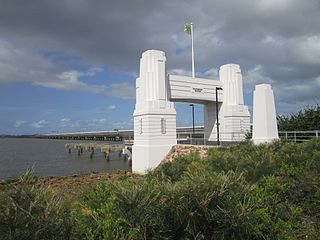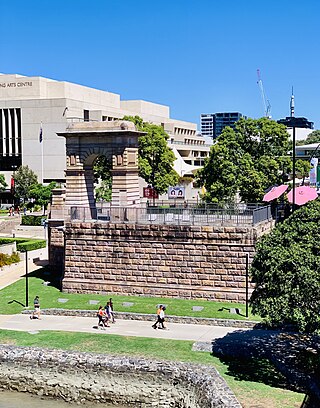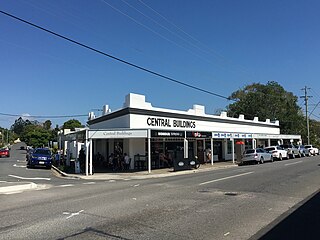
The Victoria Bridge is a bus and pedestrian bridge over the Brisbane River. The current bridge, opened in 1969, is the third permanent crossing erected at this location. Since 24 January 2021, the bridge has been closed to general traffic, and now carries buses, pedestrians and cyclists only.

Albert Bridge is a heritage-listed railway bridge of steel truss design crossing the Brisbane River between Indooroopilly and Chelmer in the City of Brisbane, Queensland, Australia. It was designed by Henry Charles Stanley and built from 1894 to 1895 by John McCormick & Son as a replacement for an earlier bridge lost to flooding in 1893. Both bridges were named in honour of the Prince of Wales, Prince Albert. It was added to the Queensland Heritage Register on 21 October 1992.

The Jack Pesch Bridge is a pedestrian and cyclist bridge that crosses the Brisbane River. It is named in honour of Jack Pesch, a cycling champion during the 1930s. He subsequently ran a bicycle shop in Petrie Terrace, Brisbane, until the mid-1990s, selling and servicing his own 'Rocket' cycles and cycle parts.

Hornibrook Bridge is a heritage-listed mostly-demolished road bridge on the Hornibrook Highway over Hays Inlet at Bramble Bay from Brighton, City of Brisbane to Clontarf, City of Moreton Bay, Queensland, Australia. It was designed by Manuel Hornibrook and built from 1932 to 1935 by Manuel Hornibrook. It was added to the Queensland Heritage Register on 7 October 1994.

Indooroopilly railway station is located on the Main line in Queensland, Australia. It serves the Brisbane suburb of Indooroopilly. Immediately south of the station, the line crosses the Brisbane River via the Albert Bridge.

Graceville railway station is a heritage-listed railway station at 110 Long Street, Graceville, City of Brisbane, Queensland, Australia. It is on the Main line, serving the suburb of Graceville. It was designed by John Sidney Egan and Jan Kral and built from 1958 to 1959 by Railways Department. It was added to the Queensland Heritage Register on 12 June 2009.

The Hercílio Luz Bridge, located in Florianópolis, the capital city of Santa Catarina State in southern Brazil, is the first bridge constructed to link the Island of Santa Catarina to the mainland.

Indooroopilly is a riverside suburb 7.8 kilometres (4.8 mi) south-west of the Brisbane CBD, Queensland, Australia. In the 2021 census, Indooroopilly had a population of 13,622 people.

Chelmer is a south-western suburb in the City of Brisbane, Queensland, Australia. In the 2021 census, Chelmer had a population of 3,325 people.

Graceville is a suburb in the City of Brisbane, Queensland, Australia. In the 2021 census, Graceville had a population of 4,764 people.

Indooroopilly was an electoral district of the Legislative Assembly in the Australian state of Queensland from 1992 to 2017.

The Indooroopilly Railway Bridge is a railway bridge of steel truss design which crosses the Brisbane River, Queensland, Australia. The Indooroopilly Railway Bridge links Indooroopilly and Chelmer stations, and has two long spans with one central pier. It was built just upstream and parallel to the Albert Bridge as part of the quadruplication of the Ipswich Line between 1955 and 1957.

Walter Taylor (1872–1955) was an Australian contractor and builder of many Brisbane landmarks. His most notable works are the Walter Taylor Bridge and the Graceville Methodist church, both of which are heritage-listed buildings.

The Shire of Sherwood is a former local government area of Queensland, Australia, located in south-western Brisbane in and around the suburb of Sherwood.

Graceville Uniting Church is a heritage-listed former Uniting church at 215 Oxley Road, Graceville, City of Brisbane, Queensland, Australia. It was designed and built by Walter Taylor from 1917 to 1951. It was previously known as Graceville Methodist Church. The associated churchyard complex was added to the Queensland Heritage Register on 24 September 1999.

Sadliers Crossing Railway Bridge is a heritage-listed railway bridge at over Bremer River between Tallon Street, Sadliers Crossing and Dixon Street, Wulkuraka, Queensland, Australia on the Main Line (this section is now the Ipswich and Rosewood railway line. It was added to the Queensland Heritage Register on 13 November 2008.

Victoria Bridge Abutment is a heritage-listed road bridge remnant at 74 Stanley Street, South Brisbane, City of Brisbane, Queensland, Australia. It was designed by Alfred Barton Brady and built in 1896 by Arthur Midson. It was added to the Queensland Heritage Register on 21 August 1992.

Alexandra Railway Bridge is a heritage-listed railway bridge adjacent to North Street, Rockhampton, Rockhampton Region, Queensland, Australia. It was designed by Henry Charles Stanley and built from 1898 to 1899 by George Charles Willcocks. It was added to the Queensland Heritage Register on 21 October 1992.

The Central Buildings are a heritage-listed series of six shops located at 327 Honour Avenue, Graceville, Brisbane, Queensland, Australia. They are located between Verney Road West and Rakeevan Road. They are listed on the Brisbane Heritage Register.






















